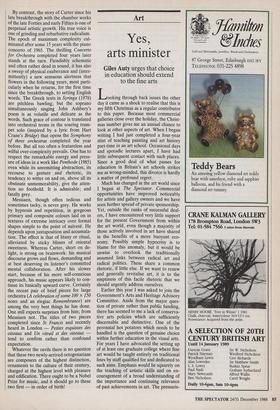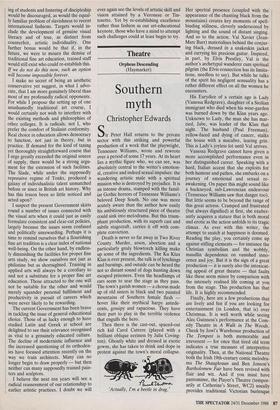Art
Yes, arts minister
Giles Auty urges that choice in education should extend to the fine arts Loolcing through back issues the other day it came as a shock to realise that this is my fifth Christmas as a regular contributor to this paper. Because most commercial galleries close over the holiday, the Christ- mas number gives me an annual chance to look at other aspects of art. When I began writing I had just completed a four-year stint of teaching painting and art history part-time in an art school. Occasional days and sporadic lectures apart, I have had little subsequent contact with such places. Since a good deal of what passes for education in Britain's art schools strikes me as wrong-minded, this divorce is hardly a matter of profound regret.
Much has changed in the art world since I began at The Spectator. Commercial opportunities have improved noticeably for artists and gallery owners and we have seen further spread of private sponsorship Yet, outside the ranks of successful deal- ers, I have encountered very little support for the present Government from within the art world, even though a majority of those actively involved in art have shared in the benefits of a more buoyant eco- nomy. Possibly simple hypocrisy is to blame for this anomaly, but it would be unwise to overlook the traditionally assumed links between radical art and radical politics. These share a common rhetoric, if little else. If we want to renew and generally revitalise art, it is to the emptiness of this facile rhetoric that we should urgently address ourselves.
Earlier this year I was asked to join the Government's Arts and Heritage Advisory Committee. Aside from the major ques- tion of private rather than public funding, there has seemed to me a lack of conserva- tive arts policies which are sufficiently discernable and distinctive. One of the perennial hot potatoes which needs to be handled is the question of genuine choice within further education in the visual arts. For years I have advocated the setting up of at least one graduate college where fine art would be taught entirely on traditional lines by staff qualified for and dedicated to such aims. Emphasis would lie squarely on the teaching of artistic skills and on en- couragement of a broad understanding of the importance and continuing relevance of past achievements in art. The pressuris 11., - ing of students and fostering of discipleship would be discouraged, as would the equal- ly familiar problem of slavishness to recent international fashions. Targets would in- clude the development of genuine visual hteracy and of true, as distinct from counterfeit, artistic individuality. One further bonus would be that if, in the future, we were to mourn the demise of traditional fine art education, trained staff would still exist who could re-establish this. If we do not do this now, such an option will become impossible forever.
I make no secret of being an aesthetic conservative yet suggest, in what I advo- cate, that I am more genuinely liberal than most of my professedly radical opponents. For while I propose the setting up of one unashamedly traditional art course, I would certainly not wish to interfere with the existing methods and philosophies of other colleges. It is radicals, not I, who prefer the comfort of Stalinist conformity. Real choice in education allows democracy to function, not just in theory, but in practice. If demand for the kind of taxing yet thoroughly straightforward course that I urge greatly exceeded the original source of supply, there would be a strong argu- ment for the extension of such facilities. The Slade, while under the supposedly repressive regime of Tanks, produced a galaxy of individualistic talent unmatched before or since in British art history. Why has this lesson been so little noticed and acted upon?
I suspect the present Government skirts round a number of issues connected with the visual arts when it could just as easily formulate consistent and clear-cut policies, largely because the issues seem confused and politically unrewarding. Perhaps it is time to remind ourselves that a flourishing fine art tradition is a clear index of national well-being. On the other hand, by endless- ly diminishing the facilities for proper fine arts study, we show ourselves not just as philistine but as shortsighted. Training in applied arts will always be a corollary to and not a substitute for a proper fine art education. Those attracted to the one will not be suitable for the other and would merely squander personal fulfilment and productivity in pursuit of careers which were never likely to be rewarding. The current Government has been brave in tackling the issue of general educational choice. Those of us lucky enough to have studied Latin and Greek at school are delighted to see their relevance recognised as vital to a genuinely educated culture. The decline of modernistic influence and the increased questioning of its orthodox- ies have focused attention recently on the way we train architects. Many can no longer begin to draw properly — but then neither can many supposedly trained pain- ters and sculptors.
I believe the next ten years will see a radical reassessment of our relationship to earlier artistic practices. I doubt we will ever again see the levels of artistic skill and vision attained by a Veronese or Tin- toretto. Yet by re-establishing excellence rather than fashion as our art-educational keynote, those who have a mind to attempt such challenges could at least begin to try.











































































































 Previous page
Previous page